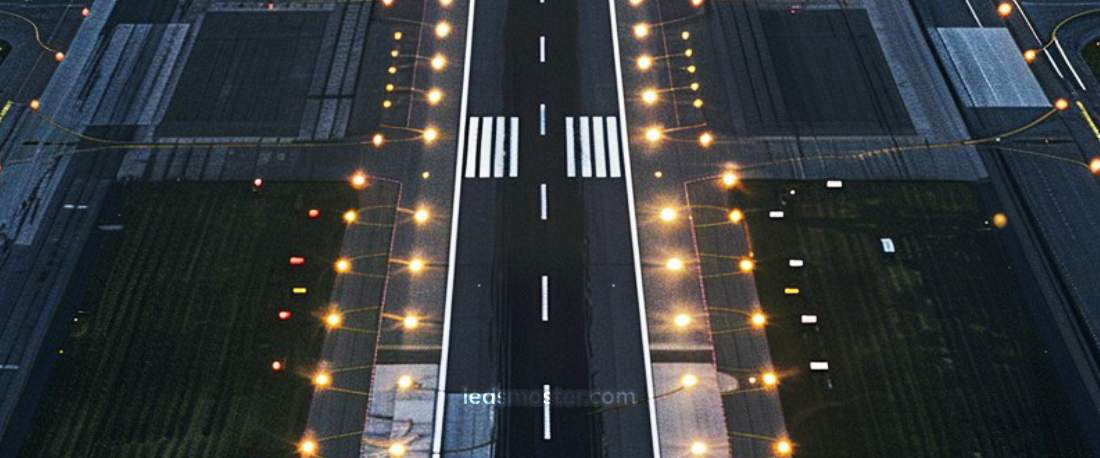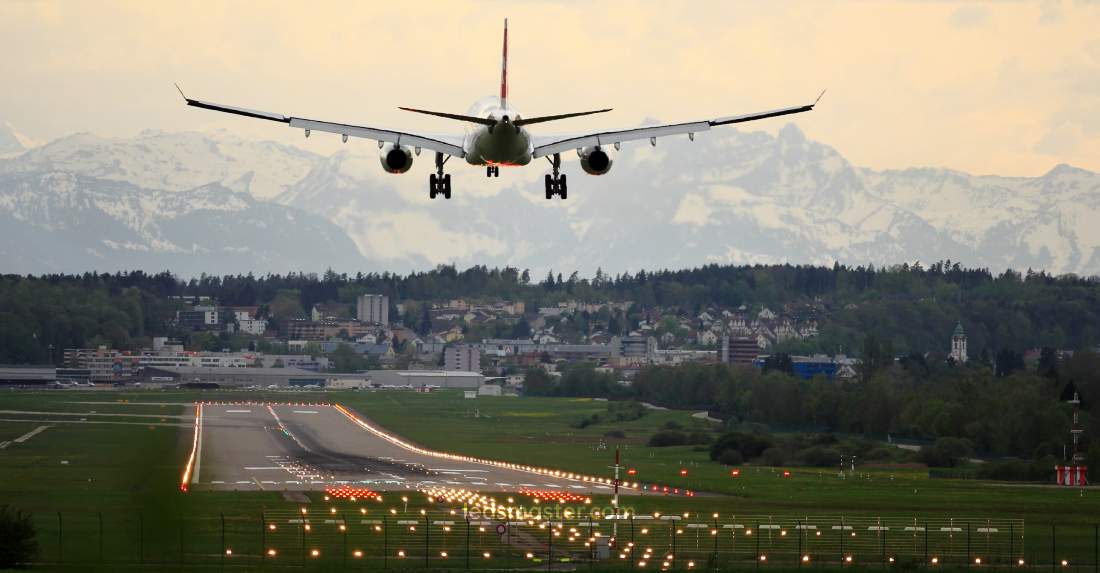Our advanced lighting solutions enhance runway visibility and pilot guidance, contributing to operational safety and precision. With durable, energy-efficient designs, our products provide reliable performance and support seamless airport operations.
Airport runway lighting provides the necessary visual guidance for pilots during takeoff, landing, and taxiing, especially under low visibility conditions such as night or inclement weather. The design, requirements, and technology behind runway lighting systems are sophisticated and are subject to stringent international regulations. This article explores the key aspects of runway lighting, including its types, design considerations, regulatory standards, and technological advancements.
Get your complimentary lighting design today
Table of Contents
ToggleRunway lighting plays a pivotal role in aviation safety and operational efficiency. By providing clear visual cues, these systems help pilots maintain correct alignment with the runway, determine the runway’s end, and ensure proper spacing between aircraft. This is crucial for preventing runway incursions and accidents, thus enhancing overall airfield safety.
Runway lighting systems improve visibility in various conditions, including nighttime, fog, rain, and snow. They enable pilots to identify runway edges, centerlines, thresholds, and touchdown zones, thereby facilitating accurate landings and takeoffs. Additionally, they support ground control operations, aiding in the smooth and safe movement of aircraft on the tarmac.

High-Intensity Runway Lights (HIRL) are used on major airports’ primary runways. They provide maximum visibility and are critical for runways with precision instrument approaches. HIRLs are typically installed at intervals along the runway edges and can be adjusted for intensity based on visibility conditions, which helps pilots during varying weather situations.
Medium-Intensity Runway Lights (MIRL) are generally used on secondary or less critical runways. They provide sufficient visibility for aircraft operations but at a lower intensity than HIRLs. MIRLs are suitable for airports with less frequent traffic and fewer adverse weather conditions.
Low-Intensity Runway Lights (LIRL) are used at smaller airports or airstrips where high-intensity lighting is unnecessary. LIRLs provide basic visual guidance for pilots and are typically used in regions with low air traffic and clear weather conditions.
Edge lights are placed along the runway’s sides and define its boundaries. These lights are typically white but may turn yellow as the runway approaches its end. Edge lights help pilots discern the width of the runway and its alignment during takeoff and landing.
Runway centerline lights are embedded along the runway’s center and are typically white, changing to alternating red and white, and then red only as the runway end nears. These lights provide crucial guidance for pilots, especially during low visibility, by indicating the precise centerline of the runway.
Touchdown Zone Lights (TDZL) are rows of white lights located on either side of the runway centerline, extending for 3,000 feet from the runway threshold. They assist pilots in identifying the ideal touchdown area, improving landing accuracy and safety.
Runway End Identifier Lights (REIL) consist of synchronized flashing lights installed at each side of the runway threshold. They help pilots identify the runway ends from a distance and are particularly useful during night or poor visibility conditions.
Approach Lighting Systems (ALS) extend from the runway threshold into the approach area. These systems consist of a series of light bars, strobe lights, or a combination thereof, and provide visual guidance to pilots during the final approach phase, enhancing their ability to align the aircraft with the runway.

Runway lighting design must comply with regulations set by international bodies such as the International Civil Aviation Organization (ICAO) and the Federal Aviation Administration (FAA). These standards ensure that lighting systems provide adequate visibility and are standardized globally, allowing for consistent pilot training and operational safety.
The lighting design must account for varying visibility conditions. Factors such as weather patterns, ambient light levels, and air traffic volume are considered when determining the intensity and type of lighting to be installed. High-intensity systems may be required in areas with frequent fog or heavy rain, while lower-intensity systems may suffice in clear, low-traffic regions.
The electrical infrastructure supporting runway lighting must be robust and reliable. This includes transformers, circuit selectors, and backup power sources. Electrical designs must ensure continuous operation and quick restoration in case of power failures, given the critical nature of runway lighting for airport safety.
Runway lighting systems must withstand harsh environmental conditions, including extreme temperatures, precipitation, and UV exposure. Materials used in these systems should be corrosion-resistant and durable. Regular maintenance schedules are essential to ensure that lighting remains operational, with routine checks and replacements as needed.
Light Emitting Diode (LED) technology has revolutionized runway lighting by providing energy-efficient, long-lasting, and low-maintenance solutions. LED lights offer higher brightness with lower energy consumption compared to traditional incandescent lights. They also have a longer lifespan, reducing the need for frequent replacements and maintenance.
Smart runway lighting systems incorporate advanced technologies such as sensors, automation, and remote control capabilities. These systems can adjust light intensity based on real-time weather conditions and traffic patterns, optimizing visibility and energy usage. Smart systems also allow for remote monitoring and diagnostics, improving maintenance efficiency and reducing downtime.
Solar-powered runway lights are increasingly popular for their environmental benefits and independence from grid electricity. These lights use solar panels to charge batteries during the day, providing reliable illumination at night. Solar-powered lights are particularly beneficial in remote or off-grid locations, where traditional power infrastructure may be unavailable or unreliable.
The installation of runway lighting systems requires careful planning and coordination to minimize disruptions to airport operations. Factors such as runway length, width, and surface type influence the installation process. Coordination with air traffic control and scheduling installation during low traffic periods helps mitigate operational impacts.
Maintaining consistent performance in all weather conditions is a significant challenge for runway lighting systems. Snow and ice accumulation, heavy rainfall, and dense fog can impair visibility and affect light performance. Airports must have contingency plans and maintenance protocols to address these challenges promptly, ensuring that lighting systems remain effective.
ICAO’s Annex 14 provides comprehensive guidelines for the design, installation, and maintenance of aerodrome lighting systems. These standards cover aspects such as light intensity, color, placement, and system redundancy, ensuring that runway lighting meets global safety and operational requirements.
In the United States, the FAA’s Advisory Circular 150/5340-30 sets the standards for airport lighting, including runway, taxiway, and approach lighting systems. Compliance with FAA standards is mandatory for U.S. airports and ensures consistency in lighting systems across the country, facilitating safe and efficient air traffic operations.
Future runway lighting systems are expected to integrate more closely with advanced navigation and landing systems, providing enhanced guidance and automation. Integration with technologies such as GPS-based navigation, augmented reality displays, and automated landing systems will further improve pilot situational awareness and landing precision.
Sustainability will continue to drive innovations in runway lighting, with greater emphasis on reducing energy consumption and environmental impact. Advances in renewable energy sources, such as solar and wind power, and materials with lower environmental footprints will contribute to the development of greener runway lighting solutions.
Data analytics will play a more significant role in runway lighting management, with systems capable of collecting and analyzing performance data in real-time. This will enable predictive maintenance, optimize energy usage, and improve overall system efficiency, reducing costs and enhancing reliability.
Runway lighting is a vital component of airport infrastructure, ensuring safe and efficient operations in all visibility conditions. From traditional incandescent systems to modern LED and solar-powered solutions, the technology behind runway lighting has evolved significantly, offering enhanced visibility, energy efficiency, and reliability. Compliance with international standards and ongoing technological advancements will continue to shape the future of runway lighting, contributing to safer and more efficient air travel worldwide. As airports adapt to changing demands and environmental considerations, runway lighting systems will remain a cornerstone of aviation safety and efficiency.